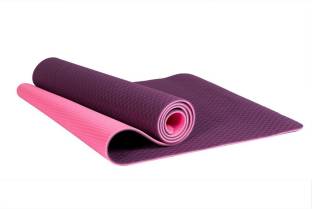When I started learning yoga I used the dhurrie -- the carpet we use in India -- because I could not afford a yoga mat. Plus, I had never seen a sticky mat before and was very intrigued such a thing existed. I used the Rs 100-dhurrie throughout my teacher training. Thpse days the ashram where I got my TTC sold such mats for us poor Indians. This was a cheaper dhurrie variety -- the footmat sort of weave -- would fold up in several poses. But I never felt at a disadvantage using it, ever. For me the mat was just something to keep dust off me, and was any case easier to wash than the plasticky sticky mat. So I guess I fitted the idea of austerity and abstinence required of us yoga practitioners!
But nowadays I have many varieties of mat because I have become indulgent (which shows how much truer we are to the principles of anything as beginners and lose it along the way ha ha:). So after the motorbike (that everybody who follows me is aware of) accident with every joint having been thoroughly socked (including an old injury at the knee, just when I thought I had sorted it) I decided to buy a softer, foamy thick mat. I have been using it for the last few months and realised that it is actually aggravating the stress at my joints-- every joint has become more sensitive due to it -- my wrists, my knees, my shoulders especially. So I dug out my older and worn out mat and feel better already. And though it is mud-stained from a yoga practice in the park, I prefer it these days.
So here is a lowdown on how to choose your mat:
The non-fussy medium range non-sticky mat is the best. The more expensive foam or thick mat is good only for those doing therapy poses. It is gentle on the knees when you land on it or keep it there for poses like the cat stretch. But for the intermediate level practice which may include sun salute you do not want this mat. While it softens the cushioning at the knees, it also destablises it in lunges etc making it more painful later on. You will find that even planks, long holds in poses like the headstand, stresses all the joints in these softer mats because they are so soft and aggravate any joint problem you may already have.
Similarly standing poses are tougher on these thicker mats -- which may add up to improving your poses by over-challenging them. But in a class if you are already shaky, it is going to wobble you more.
I have used the expensive mats which have jute base at the bottom -- it will slide madly on a slippery floor but is otherwise good and strong. The thicker mats sold by all brands -- they shred faster, because the brands realise that if you can afford to buy the more expensive variety you are also rich enough to dump it soon:)
Happy sadhana!
But nowadays I have many varieties of mat because I have become indulgent (which shows how much truer we are to the principles of anything as beginners and lose it along the way ha ha:). So after the motorbike (that everybody who follows me is aware of) accident with every joint having been thoroughly socked (including an old injury at the knee, just when I thought I had sorted it) I decided to buy a softer, foamy thick mat. I have been using it for the last few months and realised that it is actually aggravating the stress at my joints-- every joint has become more sensitive due to it -- my wrists, my knees, my shoulders especially. So I dug out my older and worn out mat and feel better already. And though it is mud-stained from a yoga practice in the park, I prefer it these days.
So here is a lowdown on how to choose your mat:
The non-fussy medium range non-sticky mat is the best. The more expensive foam or thick mat is good only for those doing therapy poses. It is gentle on the knees when you land on it or keep it there for poses like the cat stretch. But for the intermediate level practice which may include sun salute you do not want this mat. While it softens the cushioning at the knees, it also destablises it in lunges etc making it more painful later on. You will find that even planks, long holds in poses like the headstand, stresses all the joints in these softer mats because they are so soft and aggravate any joint problem you may already have.
Similarly standing poses are tougher on these thicker mats -- which may add up to improving your poses by over-challenging them. But in a class if you are already shaky, it is going to wobble you more.
I have used the expensive mats which have jute base at the bottom -- it will slide madly on a slippery floor but is otherwise good and strong. The thicker mats sold by all brands -- they shred faster, because the brands realise that if you can afford to buy the more expensive variety you are also rich enough to dump it soon:)
Happy sadhana!



No comments:
Post a Comment